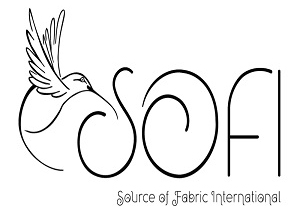In the ever-evolving world of fashion, sustainability has taken center stage, and deadstock fabric wholesale is becoming a game-changer. Designers and brands are increasingly turning to deadstock materials, which are leftover fabrics from manufacturers, to create unique and eco-friendly collections. This approach not only reduces waste but also offers a treasure trove of diverse textiles waiting to be transformed into stunning garments.
For businesses looking to stand out in a competitive market, sourcing deadstock fabric can provide a distinct edge. With a wide variety of colors, textures, and patterns available at wholesale prices, it’s an opportunity to innovate while promoting environmental responsibility. As the demand for sustainable fashion continues to rise, understanding the benefits of deadstock fabric wholesale is essential for anyone aiming to make a mark in this vibrant industry.
What Is Deadstock Fabric?
Deadstock fabric refers to leftover materials that manufacturers produce but do not use in final products. This fabric often remains unused due to overproduction or design changes. Designers and brands frequently seek out deadstock fabric to create unique collections while promoting eco-friendly practices.
Sourcing deadstock fabric offers various advantages. It provides access to a wide range of textiles at often lower prices, making it appealing for budget-conscious designers and businesses. Additionally, using deadstock fabric helps reduce waste, contributing to more sustainable fashion practices.
Deadstock fabric can include various materials, such as cotton, linen, silk, and synthetic blends. Designers can find a diverse selection, allowing for creativity and innovation in their collections. By opting for deadstock fabric, businesses can differentiate themselves in a competitive market and support environmental responsibility.
Benefits of Deadstock Fabric Wholesale
Sourcing deadstock fabric wholesale offers several key advantages for designers and brands in the fashion industry.
Sustainability Advantages
Utilizing deadstock fabric supports eco-friendly practices by minimizing waste. This fabric comes from unused materials, resulting from overproduction or design changes, thus reducing the environmental impact of textile production. By choosing deadstock, businesses contribute to a more sustainable supply chain, encouraging responsible sourcing. Additionally, this approach promotes recycling and repurposing, facilitating a circular economy that benefits both the planet and the fashion industry.
Cost-Effectiveness
Deadstock fabric offers significant savings for budget-conscious designers. Wholesale pricing allows for access to a range of materials at lower costs than traditional fabrics. This affordability enables brands to create diverse collections without overspending. Plus, the unique nature of deadstock fabric invites creativity, as each batch may contain varied textures and colors. By maximizing their budget while obtaining quality materials, businesses enhance their competitive edge in the market.
Sourcing Deadstock Fabric
Sourcing deadstock fabric involves finding wholesale suppliers who offer a variety of leftover textiles. This practice supports sustainable fashion and can provide unique materials at lower prices.
How to Find Reliable Suppliers
Finding reliable suppliers of deadstock fabric requires research. Start by checking online platforms that specialize in surplus materials. Trade shows and fabric markets often feature vendors selling deadstock options. Networking with other designers can lead to recommendations for trustworthy sources. Look for reviews and testimonials to gauge the reliability of suppliers before making purchases.
Factors to Consider When Purchasing
- Quality: Assess the fabric’s condition to ensure it will meet design needs.
- Material Variety: Look for a range of textile options, including cotton, linen, and blends.
- Pricing: Compare prices among different suppliers to find the best deals.
- Minimum Order Quantity: Understand the supplier’s minimum order requirements to avoid excess stock.
- Shipping Costs: Calculate shipping expenses to determine the total cost of the fabric.
- Sustainability Practices: Verify the supplier’s commitment to sustainable sourcing to align with eco-friendly goals.
Uses of Deadstock Fabric
Deadstock fabric serves various purposes across different sectors, making it a valuable resource for creatives and businesses alike.
Fashion and Apparel
Fashion designers often use deadstock fabric to create unique clothing items. It allows for creativity since each piece may have different colors, textures, and patterns. Many brands choose deadstock to produce limited collections, ensuring their offerings stand out. Designers benefit from accessing quality materials at lower prices. For example, using leftover silk or cotton can help create stylish dresses or shirts without the high costs associated with newly produced fabrics.
Home Décor
Deadstock fabric also finds its way into home décor projects. Home furnishings such as cushions, curtains, and tablecloths can incorporate these leftover materials. This use adds character to home designs while promoting sustainability. For instance, vibrant linen remnants can enhance a living room’s aesthetic when made into throw pillows. The diverse selection allows decorators to mix and match fabrics, providing more design possibilities.
Challenges in Deadstock Fabric Wholesale
Sourcing deadstock fabric comes with specific challenges that buyers must consider. These obstacles can affect availability, quality, and overall business operations.
Quality Control Issues
Quality control stands as a significant concern in deadstock fabric procurement. Variations in fabric quality can arise from overproduction or previous usage. Evaluating the fabric before purchasing fabric wholesale is crucial to ensure it meets specific standards. Buyers must inspect textiles for defects, inconsistencies, or damages. An inadequate quality check may result in unsatisfactory products that do not align with brand offerings.
Limited Availability
Limited availability poses another challenge in deadstock fabric wholesale. The supply of deadstock fabric often fluctuates based on production cycles or manufacturer decisions. Buyers may find it difficult to secure the amount they need for consistent production. This situation can cause delays in project timelines or limit design options. Buy Fabric Wholesale Online often faces uncertainty regarding which materials will be available, complicating their planning and sourcing efforts.
Conclusion
Embracing deadstock fabric wholesale offers a powerful opportunity for designers and brands aiming to innovate while prioritizing sustainability. By utilizing leftover materials, businesses can create distinctive collections that not only stand out but also contribute to a more eco-friendly fashion industry.
The cost-effectiveness and variety of deadstock fabrics empower designers to explore their creativity without straining their budgets. As the fashion landscape continues to evolve towards sustainable practices, integrating deadstock fabric into collections will not only enhance aesthetic appeal but also align with the growing consumer demand for responsible sourcing.
Navigating the challenges of quality control and availability is essential for success in this niche market. With careful sourcing and a commitment to sustainability, the potential of deadstock fabric can be fully realized, driving both innovation and environmental stewardship in fashion.
Frequently Asked Questions
What is deadstock fabric?
Deadstock fabric refers to leftover materials from manufacturers that were never used in final products. These fabrics often result from overproduction or design changes. By utilizing deadstock, designers can create unique, eco-friendly collections while reducing waste in the fashion industry.
How does sourcing deadstock fabric benefit designers?
Sourcing deadstock fabric allows designers to access a diverse range of textiles at lower prices. This not only helps budget-conscious designers but also promotes creativity, enabling them to incorporate unique colors, textures, and patterns into their collections, enhancing their competitive edge.
Why is sustainability important in the fashion industry?
Sustainability is vital in the fashion industry because it addresses environmental concerns related to waste and resource consumption. By adopting sustainable practices like using deadstock fabric, businesses can contribute to a circular economy, reducing their ecological footprint while meeting the growing demand for eco-friendly products.
What challenges do designers face when sourcing deadstock fabric?
Designers may encounter challenges such as quality control issues and limited availability when sourcing deadstock fabric. Variability in fabric quality can arise from previous usage, and fluctuating production cycles can make it difficult to secure consistent supplies, leading to potential project delays.
How can designers find reliable suppliers for deadstock fabric?
Designers can find reliable suppliers for deadstock fabric by researching online platforms, attending trade shows, and networking with other designers. It’s essential to assess fabric quality, explore material variety, compare prices, and verify suppliers’ sustainability practices to ensure a successful sourcing experience.


